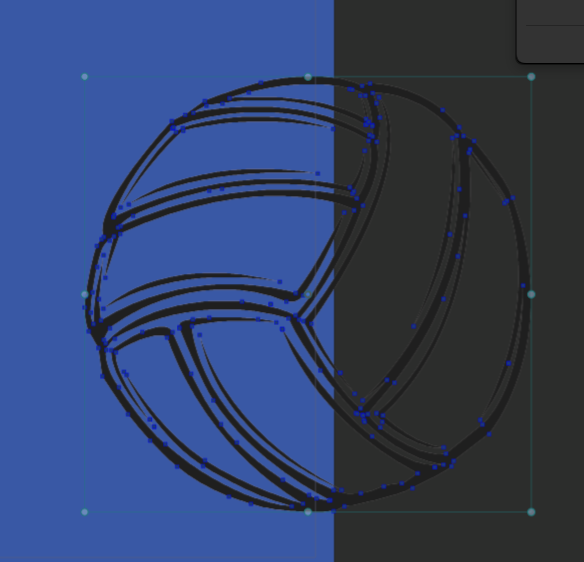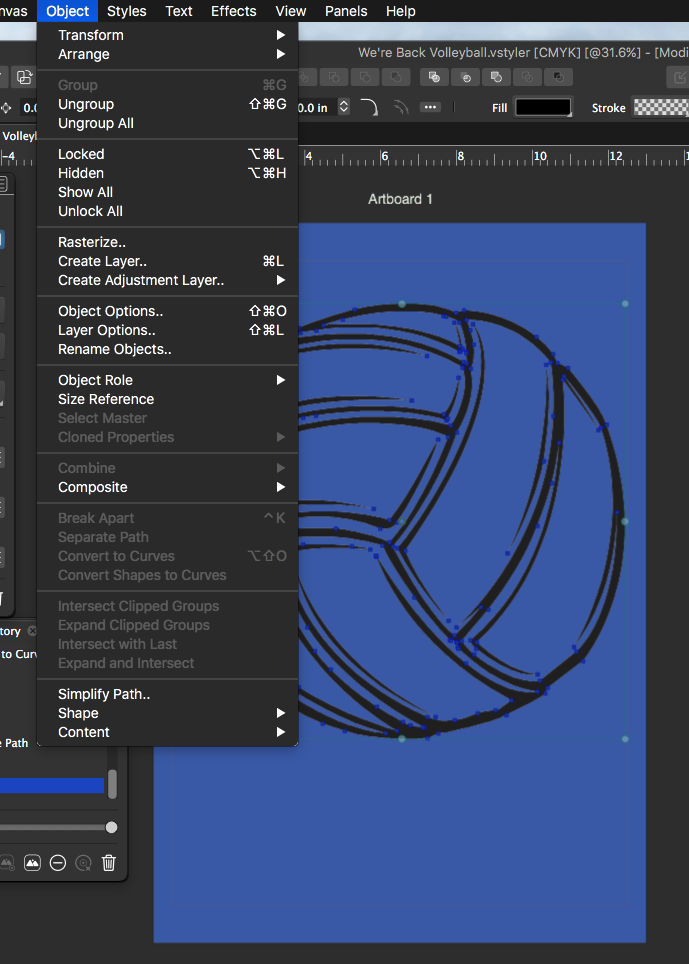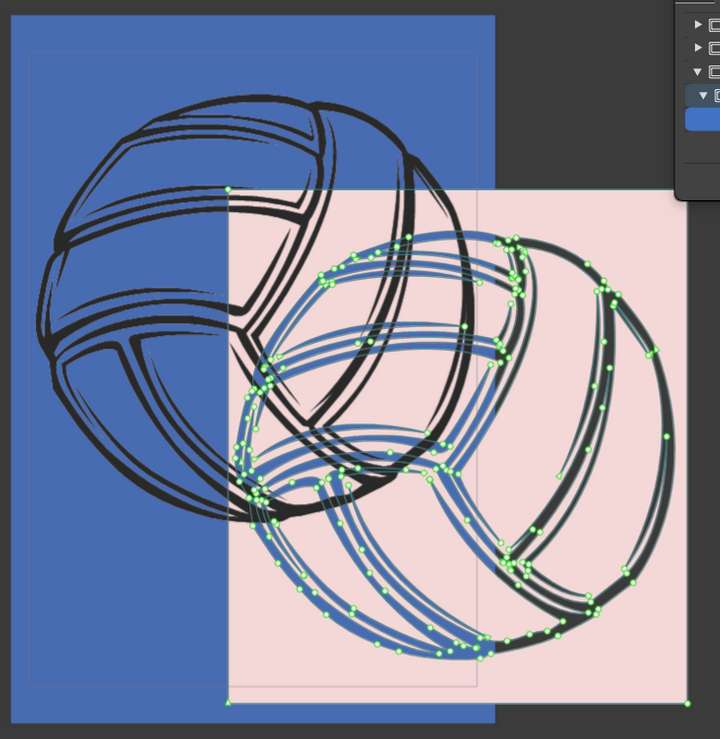Best solution for breaking apart merge results
-
What is the best way to break apart a merge result like in the video linked here?
I have a volleyball where all the black was a vector fill shape and the rest was empty space. I placed a rectangle shape behind it and converted it to curves - then selected both the volleyball and the green rectangle shape and merged them. This cut out the shapes as expected, but left all the remaining green of the rectangle as one grouping, not separate pieces. This makes sense (even in Illustrator when this task is performed, the end result is automatically grouped) What is the best way to break apart the merged grouping in VS? "break apart" works, but it results in a lot of pieces behind the shape - and not all are necessary. Is this something that could be tasked to "ungroup" or "ungroup all"? is there another setting I should use that already exists?
-
@Boldline I don't think you really needed to draw the green rectangle. For complex objects like these I would just…
- break apart the volleyball object;
- select all the resulting shapes;
- hold down Shift and click the big outer round shape of the ball (the biggest one) to deselect it;
- hit Cmd-X / Ctrl-X (Cut) to cut the objects that are selected;
- select the big shape;
- choose 'Paste Inside' from the Edit menu;
- change the color of these objects inside.
Another easier way (no breaking apart) is to just draw a different colored circle, slightly smaller than the volleyball, then send it behind it, and group them together.
-
@Boldline In some cases, instead of Break Apart, the Object -> Separate Path might be more suitable.
-
@b77 I appreciate your suggestions and in certain circumstances, those would work.
In this situation, the volleyball design is one that never had a fill to begin with. I drew it in a raster program and then live traced it and cleaned it up as a vector. So the need is there to be able to create fills in between all the black.
The steps you mention work if I already have a solid shape involved. That process also seems to be a lot of steps for a result that could be accomplished in one or two total.
The second option you mentioned works if I don't need each section of the volleyball to be a different color or clipping mask area.
It's always good to have multiple methods to complete a task

-
@vectoradmin I'm not getting a better result with "separate path". I saw where it was added in build 53, "new action to separate a path into non-overlapping parts" Can you explain more what it is supposed to do? Should it be accomplishing what I am seeking in the video example (splitting a merged result into individual parts)?
-
@Boldline Indeed, my second suggestion doesn't help if you want to color the small parts of the volleyball differently.
But the first suggestion… did you try it? Breaking apart the volleyball should convert all the "holes" into solid, fillable objects.
Once you paste them all inside the big round shape (or just leave them on top), you can color them differently, or even draw inside them after a double-click.
………………………
@vectoradmin I searched the Documentation for 'Separate Path' to see what it does, but couldn't find anything.
-
@b77 said in Best solution for breaking apart merge results:
But the first suggestion… did you try it? Breaking apart the volleyball should convert all the "holes" into solid, fillable objects.
I did try it but the break apart option is grayed out when I have the volleyball selected and attempt to use "break apart". I'm all for any options that help improve my work flow so if I'm missing something please let me know
You mentioned "Breaking apart the volleyball should convert all the "holes" into solid, fillable objects." - but does that work if the "holes" are literally empty to begin with?

-
@Boldline Ungroup it first, convert any brush strokes with 'Expand Stroke', then I guess you should combine them all into one object with Union.
Then try Break Apart.
-
@b77 said in Best solution for breaking apart merge results:
I searched the Documentation for 'Separate Path' to see what it does, but couldn't find anything.
I know this is a new feature @vectoradmin added in the last few weeks so it would not be found in documentation just yet. I know it's addition relates to this very situation i shared here. I did find it listed in the Build 53 list of improvements; "new action to separate a path into non-overlapping parts"
I had asked in this thread for a deeper explanation of use from @vectoradmin
-
@Boldline If 'Separate Path' does what you need for this case (that is, after you ungroup, expand stroke, and combine them all with Union), please post the image and explanation here.

-
@b77 Ungrouping did the trick! union was not available or accessible even, but that is because the volleyball was already one unified shape - no overlapping parts. But I understand the purpose for union in cases with multiple overlapping individual shapes.
"Break Apart" worked! I'd never considered "break apart" would result in solid fills where there was once no fill at all. That's fascinating! Thank you for sharing that. I'll be adding this to my workflow for sure.
It's great that it creates a fill where this was negative space - and I love the way "break apart" creates a solid backing fill behind everything.
Also interesting is that once I've created it using the break part method, if I select all including the backing solid fill and hit "merge" at that time, I get the individual parts I was initially wanting (individual shapes with no backing fill)The only downside to using this method is literally everything becomes the same exact fill color and you have to go in and edit the colors piece by piece. Not a big deal on a simple design, but more cumbersome on others.
All that said, I still would like to see "separate path" be the tool that I was describing initially, as I believe it was added for. Having both options would be ideal in my mind as I would use them differently
-
@b77 said in Best solution for breaking apart merge results:
@Boldline If 'Separate Path' does what you need for this case (that is, after you ungroup, expand stroke, and combine them all with Union), please post the image and explanation here.

I tried again with the volleyball and "ungrouped all" first - made sure it was all one shape (union was still not applicable here since it was always one shape). I tried "Separate Path" here at this point to see if it acted like "break apart", but it did nothing. I added the rectangle shape in the background and selected both and merged, then clicked on "separate path" and had no visible changes - the merged result was not broken up into separate parts. I don't know if there's a bug with "separate path" or I'm not using it correctly

-
@Boldline OK, so 'Separate Path' explodes any object made of separate paths into separate objects.
That's why it doesn't do anything in this case, except maybe it separates the unconnected thin brush strokes.
-
@b77 Is that any different than just "ungroup all"?
-
@Boldline Groups can be:
- individual objects grouped together;
- multiple groups that are grouped together;
- a mix of individual objects and groups grouped together.
'Ungroup' ungroups separate objects or groups that were grouped.
'Ungroup All' does successive ungrouping until any grouped groups are ungrouped.
'Separate Path' explodes one composite shape into separate objects.
-
Another problem I faced. I haven't found the perfect solution. You usually have to do something manually. If there are any holes inside it becomes a mess . i have two paths for you.
- Break Apart, then Divide and remove useless parts.
https://recordit.co/QwsCGQ3rOW
2.You could try Shapebuilder.
https://recordit.co/Vjlyyuyjxy
Sorry to post an AI link, but I get weird things out in our VS. I want to show you a possible solution to the problem Perhaps it will go better in your case on Mac.
I'm waiting for VS's Shapebuilder to handle complex shapes badly:)
- Break Apart, then Divide and remove useless parts.
-
@encart Regarding the 1st video:
No app could figure out you don't need those three strokes and remove them automatically.

You need to remove them manually before breaking the complex shape apart, so they won't leave holes in the bigger shapes.(BoldLine's problem was being able to turn the "negative space" of the volleyball shape into fillable shapes. Any unconnected brush strokes in the volleyball are needed, I think).
…………………………………
Regarding the 2nd video:
I guess the app's Shapebuilder tool can be used to "disolve" those holes left from the unconnected strokes. Is that not working?
-
@b77 Thank you for breaking that down - that makes total sense now.
So "separate path" would be the solution if I had a compound shape/ if I used the combine boolean operation prior to make a compound shape
-
@Boldline Yes, any shape made with the Composite operations in the Object menu can be "exploded" into the initial shapes with 'Separate Path'.
Not so with shapes made with the destructive Combine operations (Object > Combine).
-
@encart I appreciate your input and your idea to use the "divide" function after "break apart" makes a lot of sense. I tried it out myself and it worked well for times I don't need the backing fill shape provided by "break apart" - ( though that could also just be clicked on and deleted). Hitting the divide "shows" me the different shapes and allows for easy selection and color change
I also tried the Shapebuilder option on the mac in VS much like you did in Illustrator with mixed results. It reminds me a little of the "Live Paint" option in Illustrator and this would be a great addition to VS though I assume it's a 2.0 update. I'd even suggest the function of live paint in illustrator could just be part of the existing Shapebuilder in VS.
@vectoradmin could the shapebuilder be improved to accomplish what @encart was trying to do with shapebuilder in his video as well as my attempt in my second video??
I also saw there is a "shape paint tool" already in VS - though I need to try it out more. it wasn't working for me but it might be my lack of understanding it